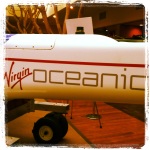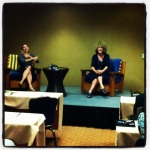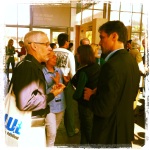Below is a guest post by wildlife photographer extraordinaire Daniel Fox of the Wild Image Project.
The dust has settled and people have finally been able to catch their breath. It is a week now since the Blue Ocean Film Festival & Conservation Summit ended. 2012 will be remembered as the year where everything changed for the production team behind the event. With a line up of ocean celebrities, European Royalties, Hollywood power, and a long list of incredible movies, BLUE has set a benchmark for what is to come in the future. Lets go back and recap what happened.
DAY 1
Even if the official start was on Monday September 24th, there was plenty of action already happening the day before, on Sunday. Familiar faces started to roll into the hotel while submersibles from the Waitt Foundation, Ocean Gate, Virgin Oceanic and Hawkes Ocean Technologies appeared in the lobby. While the people from the Google Liquid Galaxy, Ocean Futures Society, Woods Hole Oceanographic Institute, Ocean Footage, 5 Gyres and many more were busy settling down their booth, Surfrider and Congressman Sam Farr were entertaining and helping a group of children cleaning the beach of trash. Armed with a bag and gloves, everyone picked up a fair amount of cigarette butts, plastic bags, cans, plastic debris, empty bottles, and even a shoe. Even though it was great to see such enthusiasm for collecting people’s left overs, I couldn’t stop thinking about how our relationship with nature has changed. When I grew up, nature was a place to have fun, to explore, to play hide and seek, to get lost, to experiment, to wander – and through this, one came to develop the love and care it so deserves. Now, nature has become a debate, an ideology, a place where we ask children to go and clean up our mess. We tell them it is their duty to do so. Personally I question the long term effect for this strategy. Already surveys are coming out pointing to the next generation and discovering that their care for the environment and nature is at a record low. But this issue is for another time. Right now, looking at these kids roaming the sand searching for things that don’t belong there, I was just happy that there were out and not inside somewhere, watching television or on the computer.
Towards the end the afternoon, I met with documentary filmmaker and adjunct professor of Science and Natural History Filmmaking at Montana State University, Gianna Savoie. We talked for quite a while about the difficulties and challenges of transforming the scientific narrative into a story that people can connect with. Competing for attention, our world is no more forced to listen or watch – the internet and the democratization of knowledge and information have changed the way people learn. They don’t want to simply be told the facts, what matters is the personal story behind it. The human element. The emotions. For the scientific community, this reality and necessity is a complicate task to understand. Their funding often now depends on reaching out to places and people who don’t want to read through hundreds of pages of data, but instead they want to feel the emotional connection.
In the evening, the press was invited at Peter B’s Brewpub for a long night of food and home brewed beer tasting. Quite a feast!
DAY 2
I started the day by having breakfast with legendary Captain Don Walsh. Our mutual friend Josh Bernstein has suggested we meet and thank god he did. Walsh, a retiree Navy Captain, is an oceanographer and expert in marine policy. He was the first to reach the bottom of the Mariana Trench on January 23, 1960, aboard the submersible Trieste together with Jacques Piccard. He was also the last one to say goodbye and the first one to say welcome back to James Cameron on his personal breaking record visit to the deepest point of the world’s oceans (DeepSea Challenger). The Captain was here not only as part of the Ocean Elders but also to receive a Life Achievement Award. At one point, Jean Michel Cousteau passed by our table and the two of them entered a long chat, remembering many past friends. When Walsh told Cousteau that the Chinese had already been down in the Mariana Trench three times since Cameron, collecting many samples and specimens, he simply couldn’t believe that no one knew about this. How was it that no one had heard about this? He asked.
Following our conversation from the day before, Gianna Savoie was now part of a panel, along with Alyson Barrat from Living Oceans Foundation, Blair Palese from Antarctic Ocean, Charlotte Vick from Google Ocean & Mission Blue, Annelore Reisewitz from Strategic Ocean Solutions and Kathleen Flood from Cascade Game Foundry. The title of the discussion was “Communicating Science: Mastering Science Storytelling”. During her presentation, Alyson put up on screen a live “Skype” conversation with Captain Philip G. Renaud, aboard the Foundation’s boat in the French Polynesia. Palese talked about their incredible campaign they have going on right now in anticipation of CCAMLR’s meeting on the faith of conservation for the Antarctic Ocean. Called “I’m Watching”, the strategy maximises the current technologies and social media. Charlotte Vick talked about the impact Google Earth has and how one little entry can generate millions of views. Finally Gianna presented to the crowd the amazing Pacific Voyager project. Combining culture, science and indigenous heritage, the expedition is a marvel, bridging historical knowledge and practises with today’s need to connect to something deeper.
At the same time at the theatre, Louie Psihoyos was presenting for the Encore Series, his 2009 Academy Award movie The Cove. Also in other rooms, Craig Eastman talked about the importance of music in storytelling while Craig Adkins showed us the incredible capacities of the GoPro and how this tiny camera has changed the way we see the world.
The evening was marked by the official opening event. On stage, taking turns, Congressman Sam Farr, BLUE Founder Debbie Kinder, Jean-Michel Cousteau and Dr. Sylvia Earle each welcome the crowd. While most talked about the importance of educating and breaching outside of the ocean community, Jean-Michel spent much of his speech talking about the very sad episode of Morgan, an orca that was recently captured and is now in captivity in a private park in the Canaries. Dan Basta, director of the office of National Marine Sanctuaries at NOAA, surprised everyone by honouring the work of Debbie and her daughter Sara. The evening was followed by the screening of Otter 501 and ended with a light buffet. The tone was set and tomorrow was going to be another incredible day!
DAY 3
The day began with a series of really interesting classes and presentations. Emmy Award winning wildlife cinematographer Andy Brandy Casagrande IV treated the audience with absolutely stunning footage taken with the Phantom camera. Andy showed the power of slow motion and how it can be carefully integrated in a strong documentary narrative. The lively Chris Palmer taught in his class what was needed to raise money for cinematographic nature projects. Palmer could’t be more qualified. He has been a pivotal figure in several multi-million dollar projects and is now president of the One World One Ocean Foundation. While Corinne Bourdeau and Mary Elizabeth Murphy from 360? Communications talked about the whole distribution aspect of documentaries, a discussion around the use of laws and lawsuits to solve the biggest plastic pollution problems was taking place on the main stage. Lisa Boyle from the Huffington Post, Christopher Chin from the Centre for Oceanic Awareness, Research, and Education, Rachel Doughty, Attorney, Leila Monroe from the Natural Resources Defence Council, and Saskia VanGendt, U.S. Environmental Protection Agency (EPA) looked at how legislations and regulations were either helping conservation efforts or not, and what could be done to fix the process.
Running in between sessions, my next stop was Fabien Cousteau’s talk – an insightful presentation of what it meant to be brought up in an ocean family legacy. That legacy continued right after with Fabien’s father, Jean Michel, as he presented the screening of his documentary “My Father the Captain: Jacques Yves Cousteau”. Revisiting the adventures and the legacy of Captain Cousteau through intimate stories from his family, Jean-Michel also gave a voice to the people whose lives were influenced by the famous “Commandant”. Also present was Celine, Fabien’s sister, with her new baby – the next generation of Cousteau!
While Captain Don Walsh talked about his career on the main stage in a conversation with John Racanelli, CEO at National Aquarium, I met with Marine Vice Chair for IUCN’s World Commission on Protected Areas Dan Laffoley. Laffoley is also an advisor for my E.P.I.C. expedition. Together we joined Dr.Sylvia Earle and her team for the Mission Blue cocktail reception. Ocean Elder Graham Kelleher made the crowd laugh with his incredible wit and unforgiving australian accent. Blair from Antarctic Ocean reminded everyone of what was at stake down south, and Anatoly Sagalevich, deep sea legend and dear friend of Sylvia, delighted the audience with some of his personal stories.
The day ended in style with a screening of Finding Nemo in 3D, hosted by Walt Disney Studios. Paul Baribault, VP of marketing greeted the audience and explained the complicated process of turning a simple animated 2D movie into a unforgettable 3D experience. He also took the occasion to announce Disney Nature’s next project “Bears”, coming to theatre in 2014. The movie, directed by Keith Scholey (African Cats) and Alastair Fothergill (Earth, Chimpanzee), was shot in Alaska in the Katmai National Park and followed the “day-to-day lives” of the brown bears.
The rest of the days coming later this week!






Leave a Reply